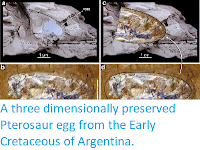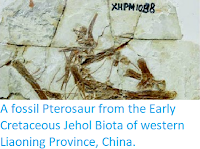Pterosaurs first appeared in the Triassic, and were the first vertebrate group to achieve powered flight, long before the appearance of Birds. They had membranous wings supported on their elongated fourth digits, and moved on all fours when on the ground. The Pterosaurs underwent a major radiation at the beginning of the Jurassic, then a second radiation at the beginning of the Cretaceous when a more advanced group of short-tailed Pterosaurs appeared and became dominant. Despite their earlier success, the group appears to have begun to decline in the Middle Cretaceous, possibly as a result of increased competition with Birds, with only a single group known from the Maastrichtian (the last six million years of the Cretaceous), the gigantic Azhdarchidae, which often weighed over 200 kg and achieved wingspans in excess of ten metres. However, this picture may be misleading, as Pterosaurs, like Birds, had fragile, hollow bones, with limited preservational potential, and most Pterosaur fossils come from fossil Lagerstätten (sites with exceptional fossil preservation), none of which is known from the last 15 million years of the Cretaceous.
In a paper published in the journal PLoS Biology on 13 March 2018, Nicholas Longrich of the Department of Biology and Biochemistry and Milner Centre for Evolution at the University of Bath, David Martill of the School of Earth and Environmental Sciences at the University of Portsmouth, and Brian Andres of the Vertebrate Paleontology Laboratory at the University of Texas at Austin, describe a diverse Pterosaur assemblage from the latest Cretaceous Ouled Abdoun Phosphate deposits of Morocco.
The Ouled Abdoun Phosphate deposits are commercially exported from a sedimentary basin to the west of the Atlas Mountains. They were laid down in a near-shore marine environment and produces numerous Marine Reptile, Pterosaur and Mammal fossils, which range from Late Cretaceous to Eocene in age. These strata have not been formally split into stratigraphic divisions by geologists, but instead have been divided into a series of couches (beds) for mining purposes, with one of these, Couche III, being dated through carbon and oxygen isotope chemostratigraphy to the last million years of the Cretaceous.
The first Pterosaur described by Longrich et al, is a new species of Pteranodontid, a group not previously recorded from after the Campanian (83.6-72.1 million years ago). It is given the name Tethydraco regalis, where 'Tethydraco' means 'Tethys Dragon', in reference to the ancient Tethys Sea, in which these deposits were laid down, and 'regalis' means 'royal'. The species is described from a left humerus, two ulnas, two femurs and a tibia. The humerus is 231 mm in length without the head, which is missing (this equates to a wingspan of about 5 m) and has a trapezoidal deltopectoral crest, considered to be a reliable indicator of a specimen belonging to the Pteranodontidae.
Tethydraco regalis,left humerus. In (A), ventral view, (B) dorsal view, (C) anterior view, (D) distal view, and (E) proximal view. Abbreviations: dpc, deltopectoral crest; ect, ectepicondyle; ent, entepicondyle; lc, lateral condyle; mc, medial condyle; pf, pneumatic fossa/foramen; scpr, supracondylar process; uc, ulnar crest; ut, ulnar tubercle. Longrich et al. (2018).
The second Pterosaur described is a small Nyctosaurid a member of a group known from earlier in the Maastrichtian, but not this close to the Cretaceous-Palaeocene boundary, and not previously from anywhere on the African continent. It is named Alcione elainus, from Alcyone of Trachis, who in Greek mythology was turned into a Kingfisher as a punishment for comparing her husband to Zeus, and 'elainus' which derives from the Greek 'elaino', meaning 'to wander'. This species is described from a partial skeleton including humerus, sternum, scapulocoracoid, and femur, with a fourth metacarpal, a mandible, a partial wing including the humerus, radius, ulna, parts of metacarpal IV and phalanx IV-1, and some other material also referred.
Alcione elainus, partial skeleton and metacarpal IV. (A) Right humerus in anterior view, (B) right ulna and radius in anterior view, respectively, (C) sternum in left lateral view, (D) metacarpal IV, (E) distal end of left metacarpal IV and left scapulocoracoid, and (F) right femur in posterior view. Abbreviations: co, coracoid; cr, cristospine; dc, distal condyle; dpc, deltopectoral crest; ect, ectepicondyle; fh, femoral head; gl, glenoid; gt, greater trochanter; hh, humeral head; hum, humerus; mcIV, metacarpal IV, pc, proximal cotyle; pf, pneumatic foramen; rad, radius; scpr, supracondylar process; ste, sternum; uln, ulna. Longrich et al. (2018).
The third Pterosaur described is also a Nyctosaurid, and is named Simurghia robusta, where 'Simurghia' refers to the Simurgh, a giant mythical Bird from Persian mythology, and 'robusta' means 'robust'. This species is described from a single humerus roughly 165 mm in length, with a hatchet-shaped deltopectoral crest, a feature considered to be diagnostic of Nyctosaurids. This represents an animal 5.6 times the size of Alcione elainus, raising the posibility that this may represent an adult specimen of the same species. However, Longrich et al. reject this hypothesis on the basis that all of the specimens referred to Alcione elainus show dense, avascular surface textures on their bones, which is indicative of maturity in Pterosaurs, indicating that all of these specimens were at least close to their full size.
Right humerus, Simurghia robusta. In (A), dorsal view, (B) ventral view, and (C) posterior view. Abbreviations: dpc, deltopectoral crest; msc, muscle scar; scpr, supracondylar process of the ectepicondyle; vp, ventral pillar; vt, ventral tubercle of the deltopectoral crest. Longrich et al. (2018).
The fourth Pterosaur described is also a Nyctosaurid and is named Barbaridactylus grandis, where 'Barbaridactylus' is a combination of Barbary, as in Barbary Coast, an old name for North Africa, and 'dactylo', Greek for finger, and 'grandis' means 'great' in Latin. This species is described from twelve humeri, one with an associated left radius and ulna, right femur, left scapulocoracoid, and partial right mandible. This species has a humerus up to 225 mm in length, but more slender than that of Simurghia robusta, with a deltopectoral crest that is short, broad, and subrectangular, with a weak constriction.
Skeleton of Barbaridactylus grandis. (A) Left humerus in anterior view, (B) right femur in anterior view, (C) right radius and ulna in posterior view, (D) cervical vertebra in ventral view, (E) left scapulocoracoid in medial view, and (F) posterior ramus of the right mandible in medial view. Abbreviations: co, coracoid; cot, cotyle of mandible; cvr, cervical ribs; dm, dorsal margin of mandible; dpc, deltopectoral crest; gl, glenoid; fh, femoral head; gt, greater trochanter; hh, humeral head; hyp, hypapophysis; olp, olecranon process; pex, postexapophysis; pn, pneumatopore; rad, radius; sca, scapula; scp, supracondylar process of the ectepicondyle; uc, ulnar crest; uln, ulna; vm, ventral margin of mandible. Longrich et al. (2018).
The fifth Pterosaur described is the Azhdarchid Phosphatodraco mauritanicus, previously described from the Ouled Abdoun Phosphate, of which Longrich et al. describe two new cervical (neck) vertebrae.
Phosphatodraco mauritanicus cervical vertebra. In (A), dorsal view, (B) ventral view, (C) left lateral view; (D) anterior view; (E) posterior view. Abbreviations: cot, cotyle; hyp, hypapophysis; nsp, neural spine; pex, postexapophysis; poz, postzygapophysis; prz, prezygapophysis. Longrich et al. (2018).
The sixth specimen described is another Azhdarchid cervical vertebrae, which Longrich et al. do not assign to a specific species, but suggest it shows some affinities to the giant Quetzalcoatlus, though it is clearly from a much smaller animal, with a total length of 153 mm.
Azhdarchid cervical vertebra. In (A), dorsal view, (B) ventral view; (C), left lateral view, and (D), anterior view. Abbreviations: dlr, dorsolateral ridge; hyp, hypapophysis; nsp, neural spine; pex, postexapophysis; poz, postzygapophysis; prz, prezygapophysis; pzl, prezygapophyseal laminae; vfo, ventral fossa. Longrich et al. (2018).
The final specimen described is another unidentified Azhdarchid, this time a fragment of ulna measuring 362 mm, with a missing proximal end (the end closest to the body), which may have measured up to 700 mm when complete, with a diameter that varies from 40 to 65 mm, indicative of a very large animal, with a wingspan of around 9 m.
Giant Azhdarchid ulna. Middle shaft and distal end of the left ulna, in posterior view. Abbreviations: ut, ulnar tubercle; vp, ventral process. Longrich et al. (2018).
Longrich et al. suggest that the discovery of Pterosaurs from three different families at the very end of the Cretaceous undermines the theory that they had been declining due to competition with Birds before the End Cretaceous Extinction Event. However, they do note that all known Late Cretaceous Pterosaurs are rather large animals, suggesting that some degree of niche partitioning was occurring at this time, with Birds occupying the small flying animal niche while Pterosaurs occupied the large flying animal niche. They suggest that in this sense, Birds could be seen as being responsible for the extinction of the Pterosaurs, since the End Cretaceous Extinction is known to have wiped out groups of large bodied animals, such as Pterosaurs or non-Avian Dinosaurs, while smaller animals, such as Birds or Mammals, scraped through.
Size disparity of late Maastrichtian Pterosaurs and Birds. Maastrichtian Pterosaurs are larger than coeval birds in Both marine (blue) and terrestrial/ freshwater (orange) ecosystems. Longrich et al. (2018).
See also...














